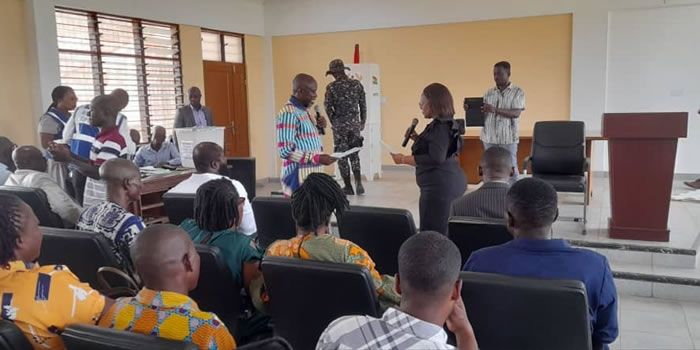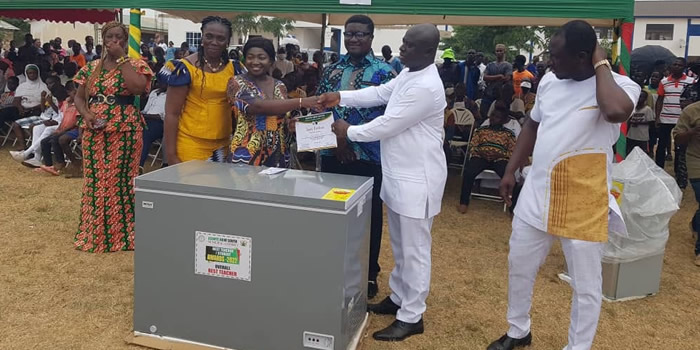

Structure of the Local Economy
Production Sectors
The economy of the Asante Akim South Municipal can be divided into three main economic sectors. These are Agriculture, Industry and Service. The agricultural sector is mainly crop farming with only minimal livestock rearing activities. The industrial sector, which is the most underdeveloped in the district, involves mainly wood based industries, block factories and agro based industries. Lumbering is also carried out in many parts of the district. The service sector involves mainly sale of farm produce, sale of some manufactured goods, tailoring, hairdressing, communication sector operators and some public and civil servants including teachers in the relatively big communities.
Agriculture
The Local economy is dominated by Agriculture sector. It employs 72.4% of the Labour force in the district. Farmers in the District are predominantly peasant farmers cultivating food crops and few cash crops. The food crops include cassava, plantain, cocoyam, yam, rice and maize. The cash crops are cocoa and oil palm, coffee, cola and oranges. It is estimated that 80% of the Internally Generated Funds to the District comes from agriculture and its related activities. About 95% of farmers finance their farming activities from their own source. Credit facilities from Banks for agriculture activities are very minimal. Another major problem of Agriculture in the district is poor storage facilities resulting in high post-harvest losses.
Industry
As the District is mostly farm lands, there is the need for the Assembly to create the necessary enabling environment such as the free zone enclave to encourage private investors and partners to establish manufacturing industries. Investors can invest in the area of steel, fertilizer production, Plastic and recycling to boost the local economy of the Asanti Akim South District Area. This is because there are more human resource and easy accessibility to raw materials. The city has the enabling environment to enhance industrialization for the private sector to develop.
Industry is the least developed sector of the local economy. With a total population of 49,920 in the Asanti Akim South District employed in the industry sector, there are 24,470 males whiles 25,450 are females. The district is dominated by the agriculture, forestry and fishing industry which represents 65.3%. This is followed by the wholesale and retail; repairs of motor vehicles and motorcycles which represent 11.1%.The Agro based industries include Gari Processing, Oil Palm Extraction and Akpeteshie distilling. The metal-based ones are mostly blacksmithing. The carpenters as well as sawmill workers dominate wood-based industry. Pottery is the main clay-based industrial activity. No manufactory facility of industrial significance is however available in the District.
Service
The service sector is dominated by the commerce sub-sector, which includes the buying and selling of both agricultural and manufactured products. It is estimated that 45% of traded items, consisting of manufactured goods and fish, are brought from outside the district notably Kumasi, Konongo and Nkawkaw. The remaining 55% basically farm produce which include plantain, cocoyam, oranges, cassava, maize and yam are produced within the District. Other activities under this sector include banking, postal and communication services, transport, police service, educational delivery, health care, tailoring and dressmaking, beauty care and other personal services.
Household Income and Expenditure
The economy of the district is primarily based on agriculture. Farmers are predominantly peasant farmers cultivating food crops and cash crops. Farmers get very little from their farms. All they get are consumed. Only few farmers have access to marketing outlets. The prices for the little that they sell are also determined by traders who come from the big towns to buy the foodstuffs. The little that they get from their main occupation cannot therefore meet their basic necessities of life. Most of the people cannot therefore afford good food, live is poor shelters and dress shabbily
Majority of the people constituting (54%) do not save. Investment is therefore low. This is as a result of the high dependency ratio as well as lack of trust in the banks. All these aggravate the unemployment situation in the district. The Asante Akim South Municipal is therefore embarking on Poverty Alleviation Schemes to improve revenue and increase employment so that the unemployment level will reduce.
The Service Sector
The service sector, which is dominated by commercial activities, constitutes the second largest sector of the local economy after agriculture. It employs about 21.6 per cent of the employed labour force.
Markets and other Commercial Activities
There are four main periodic markets in the district. They are Obogu market, which is held on Tuesdays, Adomfe, Ofoase and Kyempo markets on Fridays, Dampong market on Wednesdays and Juaso markets on Sundays. Obogu market is the biggest market in the district. A number of traders also sell farm produce along the main Kumasi-Accra road. The major problems that traders and farmers face in accessing these markets are high transport charges. This is due to the poor conditions of feeder roads in the district.
Twenty-five per cent of commodities traded in the district are cloths, 5 per cent hardware, 45 per cent foodstuffs, 15 per cent “provisions” and 10 per cent are second hand clothing. The farm produce is mainly plantain, cassava, cocoyam, kola palm oil, gari, rice and maize. Most of the manufactured commodities are brought from places like Kumasi, Konongo and Nkawkaw, which are all outside the district .Most of the traders in the district are retailers and majority of them sell their goods within the district.
The major problems that the traders face in the district are high transport charges, lack of credit facilities and fluctuation commodity of prices, which make their incomes unstable.
Investment and Business Potential
Today, the Asante Akim South Municipal has plenty of opportunity for private investment and joint ventureship with the public sector, predicated both on the district’s natural and human resources, as well as the solid infrastructure, which the District Assembly has put in place.
In the agricultural sector, studies have shown that cultivation of non-traditional crops such as pineapple, ginger, black pepper and mushrooms are suitable throughout the district. The District Assembly, therefore, encourages large-scale production of non-traditional crops. The cultivation of vegetables, such as tomatoes, pepper, garden eggs is another area of investment with rich potential.
Conditions also favour large scale cultivation of tree crops like oil palm, cocoa, coffee, cola and the establishment of woodlots. Available records show that the district has comparative advantage over all the other districts in the Ashanti Region, as far as tree crop cultivation and yields are concerned.
The district is noted for the production of food crops such as plantain, maize, cassava, cocoyam and vegetables. Cash crops like cocoa and oil palm are also extensively cultivated. Other crops of importance are citrus fruits and cola which grow well in most part of the district. Although farming activities are hampered by problems such as lack of credit facilities and inadequate access to extension services, private investors interested in agriculture can enjoy several advantages.
The district has favourable weather conditions for agriculture all year round. There is no record of extreme weather conditions, with average monthly temperature at 260 C and mean annual rainfall ranging between 1500mm and 1700mm. Almost all the various soil groups in the country can be found in the district, meaning it can support a wide range of crops.
There is great potential for the mining industry too, with reported deposits of gold and stone in various parts of the district. High value gold ore has been identified at Tokwai, Banka, Ofoase, Morso, Krofa and Asankare. So far, no meaningful mining activity is being undertaken in the district. However, in the Bana-Tokwai area, deposits have passed the exploratory stage and are now on concession. Obogu, Banso and Ofoase areas also have great potential for quarrying. There is a large stretch of stone deposits from Obogu to Ofoase, a distance of some 25 kilometres. Bompata and its outlying areas have also been identified to be containing immense clay deposits.
The large expanse of arable land lying within the rainforest belt of Ghana has suitable soils for food and cash crops like maize, cassava, plantain, cocoa, coffee, oil palm and vegetables.
The industrial sector is the least developed sector of the local economy, employing only six percent of the labour force.
However, there is plenty of unexploited potential. There is high quality wood for the wood processing industry. Indeed, over 80% of the district is covered with forest, in addition to four forest reserves covering a total area of 109.60 square kilometres. These reserves have valnuable timber species and they are felled by concessionaries under strict forestry policies. Twenty-two per cent of those employed in the industrial sector are in the wood-based industry.
Another 16% are involved in agro-based industry and agricultural raw materials are available for agro-based industry. The agricultural produce is in large quantities such that with the poor marketing facilities, most of them get rotten. Investment in these areas to turn the primary products into secondary products would boost the agricultural sector.
Also, there are large-scale clay deposits for the ceramic industry at Bompata. Feasibility studies have confirmed the high quality of the clay deposits. Some five percent of the local industrial labour force is employed in the clay-based industry. Another 11% are engaged in metal-based industries.
Types of Industries currently available are:
- Food processing (rice and corn milling),Cassava processing mostly into gari with a big potential for cassava starch and pallets
- Palm kernel and oil palm processing
- Carpentry /Wood processing (i.e. sawn lumber, manufacturing of furniture, doors and windows, etc.) No manufacturing facility of industrial significance is however available in the district.
Financial Institutions
Banking Services/Financial Institutions
There are five (5) Banking agencies in the District. Mponua Rural Bank has agencies in Asankare and Obogu. Asante Akyem Rural Bank has agencies on Juaso and Ofoase. Ghana Commercial Bank has agency at Juaso. It has, however, been observed that communities near Juansa in Asante Akim North District conduct banking services there.
Survey by the District Assembly indicates that credit/loans to productive sectors have increased. However the dominant sector, agriculture obtained the lowest credit because it is still considered high risky area for investment.
Among the reasons for not securing bank included; lack of collateral security, no bank accounts and inability to use correct credit arrangement.
Date Created : 11/23/2017 2:54:12 AM












 facebook
facebook
 twitter
twitter
 Youtube
Youtube
 +233 593 831 280
+233 593 831 280 0800 430 430
0800 430 430 GPS: GE-231-4383
GPS: GE-231-4383 info@ghanadistricts.com
info@ghanadistricts.com Box GP1044, Accra, Ghana
Box GP1044, Accra, Ghana